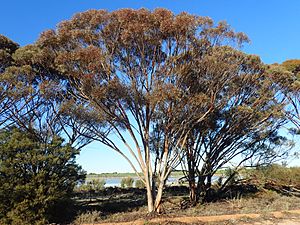Eucalyptus goniocarpa facts for kids
Quick facts for kids Eucalyptus goniocarpa |
|
|---|---|
 |
|
| Eucalyptus goniocarpa growing near Lake King | |
| Scientific classification | |
| Genus: |
Eucalyptus
|
| Species: |
goniocarpa
|
The Eucalyptus goniocarpa is a special kind of mallet tree. A mallet is a small tree that usually has just one main trunk. This tree is endemic, which means it grows naturally only in southern Western Australia.
This eucalyptus tree has smooth bark and shiny, bluish adult leaves. Its flower buds grow in groups of three. When the flowers open, they are a creamy-white color. The fruit of this tree is ribbed and shaped like a cone or a barrel.
Contents
About the Eucalyptus goniocarpa
The Eucalyptus goniocarpa is often a mallet, meaning it has a single, short trunk. It usually grows to about 5 meters (about 16 feet) tall. Sometimes, it can grow as a mallee, which means it has many stems coming from the ground, reaching about 4 meters (about 13 feet) tall. This tree does not have a lignotuber, which is a woody swelling at the base that helps some plants regrow after a fire.
Leaves and Bark
The bark of the Eucalyptus goniocarpa is smooth and can be grey or brown. Young plants and new shoots that grow from cut stems (called coppice regrowth) have long, narrow leaves. These leaves are about 45 to 87 millimeters (1.8 to 3.4 inches) long and 13 to 25 millimeters (0.5 to 1 inch) wide. They also have a small stem called a petiole.
The adult leaves are also long and narrow, but they are shiny and have a bluish color. They are about 45 to 95 millimeters (1.8 to 3.7 inches) long and 5 to 12 millimeters (0.2 to 0.5 inches) wide. Each adult leaf has a petiole up to 8 millimeters (0.3 inches) long.
Flowers and Fruit
The flower buds of this eucalyptus grow in groups of three, or sometimes seven. They are found in the axils of the leaves, which is the angle between the leaf and the stem. These buds grow on a flat, unbranched stem called a peduncle, which is about 12 to 30 millimeters (0.5 to 1.2 inches) long. Each individual bud has its own small stem, called a pedicel, about 5 to 10 millimeters (0.2 to 0.4 inches) long.
When the buds are ready, they are long and oval-shaped, or like a spindle. They are about 11 to 17 millimeters (0.4 to 0.7 inches) long and 5 to 7 millimeters (0.2 to 0.3 inches) wide. They have two wings along their sides. The top part of the bud, called the operculum, is up to twice as long as the base part, which is the floral cup.
The flowers are a creamy white color. After the flowers, the fruit forms. It is a woody capsule (a dry fruit that opens to release seeds) shaped like a cone or a barrel. The fruit is about 12 to 14 millimeters (0.5 to 0.6 inches) long and 9 to 12 millimeters (0.4 to 0.5 inches) wide. It also has two wings that extend down its pedicel.
Discovery and Naming
The Eucalyptus goniocarpa was officially described for the first time in 1992. Two botanists, Ken Hill and Lawrie Johnson, described it. They had collected a sample of the tree in 1986 with another botanist, Donald Blaxell, near Lake King. Their description was published in a science journal called Telopea.
The specific epithet (the second part of the scientific name) goniocarpa comes from two ancient Greek words. Gonia means 'an angle', and karpos means 'a fruit'. This name refers to the fruit of the tree, which has strong, noticeable wings.
Where it Grows
This eucalyptus tree mostly grows in the area around Lake King in Western Australia. It often grows in thick groups, forming what are called thickets.
Conservation Status
The Western Australian Government's Department of Parks and Wildlife has looked at the Eucalyptus goniocarpa. They have classified it as "not threatened." This means that there are enough of these trees, and they are not currently in danger of disappearing.
Images for kids



